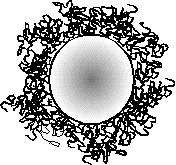Interfacial Gelatin Layers

John Hone (previous student, left the group in 1999)
This project is aimed at investigating the interactions between gelatin (denatured bovine collagen) and polystyrene latex particles. Gelatin is an amphoteric polymer, that is its net charge is dependent on the pH of the solution. The gelatin used in this study is alkali procerssed and has an iso-electric point (IEP) at pH 5. At pH 6, the natural pH of a gelatin/latex system, both the gelatin and latex are negatively charged but the gelatin still adsorbed to the surface, coating the particles, through hydrophobic and electrostatic interactions.

Schematic of a Polymer coated Particle
The gelatin/latex system has been studied by Photon Correlation Spectroscopy (PCS) and Small-Angle Neutron Scattering (SANS). It has been shown that above the IEP of gelatin, that the adsorbed layers are compressed by the addition of salt, due to shielding of the inter- and intra-molecular repulsions on the polymer backbone. The data obtained by SANS has been fitted to give volume fraction profiles of the gelatin at the interface. This has revealed that the layers are compressed by the addition of acid and swollen by the addition of base, although the derived adsorbed amounts show that some desorption may be occurring. The salt data appears to be inconsistent, however recent theoretical studies may help to shed light on the problem.
This project is funded by the EPRSC and Kodak